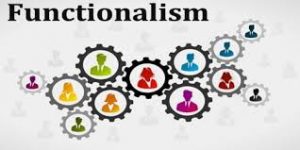The four following perspectives offer a variety of views based on how the world operates, whether it be on a micro level or macro level. These theoretical perspectives examine social problems in different ways and provide different lenses to see the world through.

Functionalist: Functionalists see that each sector of society possesses vital, specific functions within the larger whole of society (^1). The institutions of society possess specialized functions, and this perspective focuses on the macro level issues. When it comes to immigration, Functionalists would see the matter as essential within society. They would see immigrants as a source of cheap and specialized labor. Immigrants alsoprovide stability to the economy, and if they were not present, then the rest of society would be responsible to get society to reach its equilibrium. Functionalists would also see immigrants as willing to take jobs that have low wages (that U.S. citizens would be unlikely to take). Functionalists would perceive that mistreating immigrants would facilitate ill feelings between American and the nations in which the immigrants are migrating from. To them, immigrants are needed to maintain peaceful relations. Above all, Functionalists see that immigration affects the social cohesion within society. Immigration causes equilibrium, and it also provides support and unification for those who have migrated. Immigration functions as a connection within society to those who have experienced it, and it forms bonds between individuals that strengthens their positions within American society. Especially in New Jersey, there are many regions and areas in which people of similar backgrounds have congregated to keep their cultures while making it easier to acclimate to a foreign land.

Conflict: The Conflict perspective perceives society as having a constant struggle for both power and resources, and it poses that society is held together by power and coercion (^2). Politicians are most often responsible for pitting natives against immigrants. They create the conflict that is seen between the American native and immigrant. Social change is facilitated by this competition. When it comes to economics, labor and workforce cause the biggest competition. Those who oppose immigration (typically Natives) are against those who support immigration (typically immigrants). Opponents of immigration see that immigration sets native workers up at a disadvantage and causes unemployment for natives. There is an ongoing competition of jobs and occupations between natives and immigrants, and opponents see that if jobs are given to the immigrants instead of the natives, then immigrants will slowly mass more power and pose as threats. Opponents also fear that the more immigrants are permitted into this country, the more the English language will eventually fade and not be considered the primary language of the nation. Natives fear that they will become the minority with immigrants becoming the majority. Advocates of immigration argue that allowing immigrants into the workforce boosts the economy since more people are working and contributing to society. Advocates argue that immigrants use the goods and services produced by native workers, and as a result, the natives benefit from the presence of immigrants. With this perspective, the dominant groups typically win. Those in the powerful position, such as natives, exert their force to maintain their dominance over the minority groups, such as immigrants.

Feminist: The Feminist perspective premises its argument on the notion that gender as well as other areas of oppression are the sources of social inequality and social problems (^3). Upon first glance, it may be difficult to see how the immigration of many groups and genders is a feminist problem; however, women play a major role in the immigration process. Approximately 40% of undocumented women work without pay in households, where they care for their children and other family members. They run their households while their husbands are out working. Additionally, those part of the LGBTQ+ community are not permitted to sponsor partners or children for residency despite the duration or depth of their relationships. Some have owned homes with one another, and some have raised children with one another, yet they are still not permitted to sponsor their loved ones. Women and their children make up approximately 75% of those who move to the United States annually. Women are also more susceptible to experiencing abuse and exploitation by employers or family sponsors. This places a large disparity between immigrants’ experiences, facilitated by whether someone is a male or female immigrant.

Interactionalist: The interactionist perspective is fixated on how language, words, and symbols both create and maintain social reality (^4). This perspective differs because it is on the micro level and focuses on how interactions between individuals create society. This perspective would propose that the negative perception of immigrants is largely due to the images portrayed by the media. Social movements and anti-immigration sentiments had tainted the reputations of immigrants coming into America, and those attitudes shape the way individuals treat immigrants. The sentiments create animosity between natives and immigrants; fear catalyzes the mistreatment of immigrants because natives do not want to become the “other” of society. By eliciting and spreading around misrepresentations, then natives secure their positions in society while distancing themselves from immigrants. In recent years, the media has presented hispanic immigration in a negative light. There have been even commercials depicting false accusations such as them being criminals, rapists, and involved with drugs. These symbols and language affect how individuals perceive immigrants, especially those of hispanic heritage. The social environment that is then created is not equal and is based on the media people see. People represent what they see in the media and then translate it into daily life.
____________________________________________________
Bibliography
(^1, ^2, ^3, and ^4) Leon-Guerrero, Anna. Social Problems: Community, Policy and Social Action. Sixth ed. Thousand Oaks, CA: SAGE Publications, 2019.